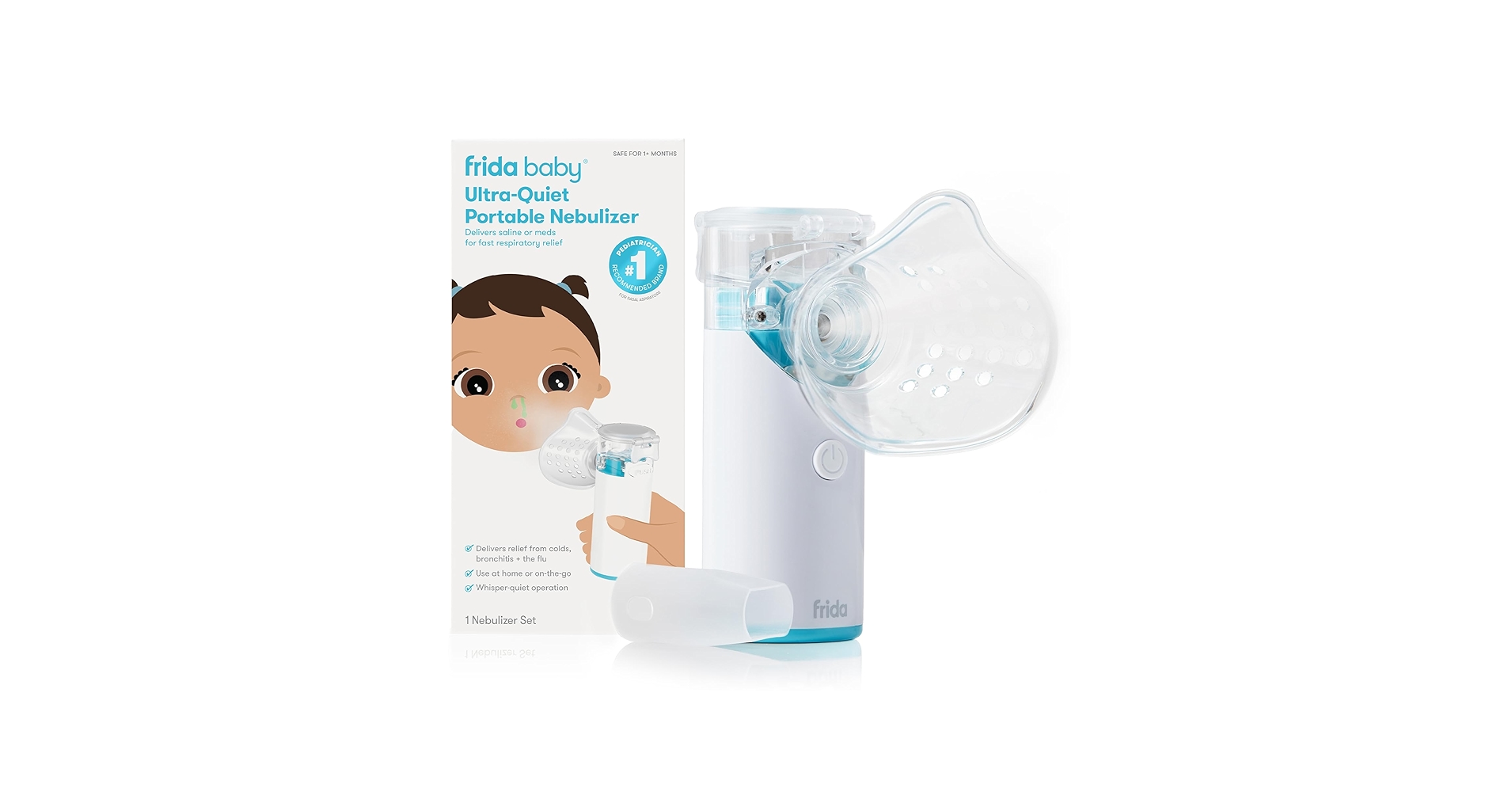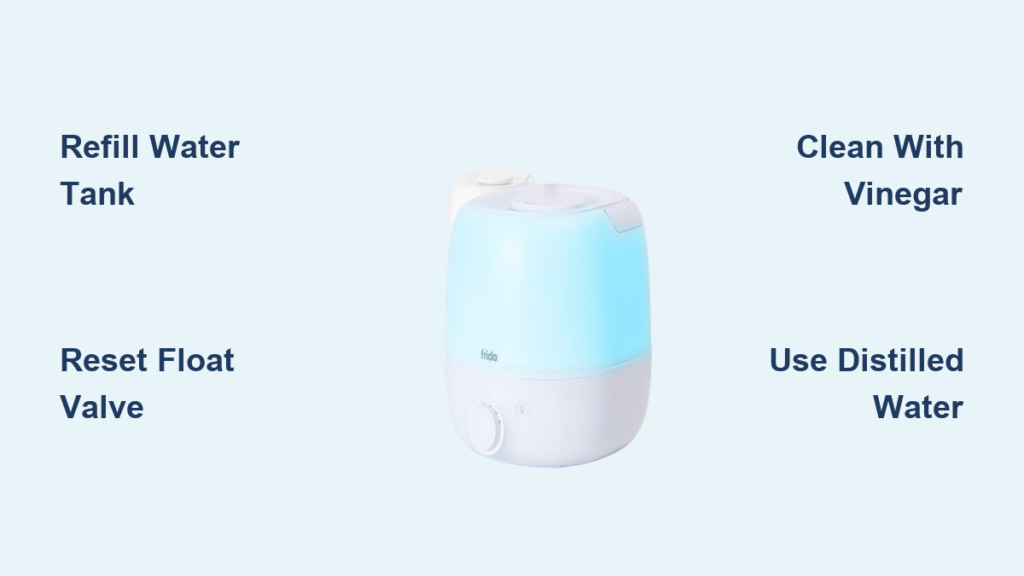Your Frida humidifier powers on, the lights glow, the fan whirs—but no mist emerges. This frustrating scenario leaves rooms dry and noses stuffy, especially when you need relief most. The good news? This common issue typically stems from just a few fixable causes rather than major component failure. Most Frida humidifier mist failures trace back to simple oversights: empty tanks, mineral blockages, or skipped cleanings. This guide walks through proven solutions to restore your mist output quickly, plus preventative steps to keep it running smoothly for years.
Why Your Frida Humidifier Has Power But No Mist Output
When your Frida humidifier lights up but produces zero mist, you’re dealing with one of three specific failures: inadequate water supply, mineral blockage, or incorrect water type. Unlike complete power failures where nothing works, this partial operation indicates the electrical components function normally while the mist generation system is compromised. Most users restore full functionality within 30 minutes by addressing these core issues—no professional repair needed.
How Frida’s Mist Generation System Actually Works
Understanding the internal mechanics helps diagnose problems faster. Inside your Frida humidifier, a small nebulizer disc (typically a metal plate at the base) vibrates at ultrasonic frequencies to convert water into fine mist. This requires both adequate water supply reaching the nebulizer and sufficient power to the vibration mechanism. When power reaches the unit but no mist appears, the problem lies in water delivery to or processing by the nebulizer system.
Immediate Diagnostic Steps Before Troubleshooting
Before diving into repairs, perform this 60-second check:
1. Verify the water tank is properly seated—listen for the distinct “click” when locking into place
2. Check for visible cracks in the tank that might cause leaks
3. Ensure the mist outlet isn’t accidentally blocked by nearby objects
4. Confirm the unit sits on a completely level surface (tilting disrupts water flow)
Refill and Reset Your Water Tank Properly
Empty or improperly seated water tanks cause 40% of “no mist” complaints despite the unit appearing operational. Frida humidifiers have precise water level requirements that many users overlook.
Correct Water Level Verification Technique
Remove the tank and examine it against a light source. The minimum operational water level sits approximately 1.5 inches above the base connector. Water below this line won’t reach the nebulizer even if the tank appears partially full. Refill to the MAX line but never exceed it—overflow can trigger automatic shutoff mechanisms that prevent mist production. Always use room-temperature water, as cold water reduces mist output by up to 30%.
Float Valve Reset Procedure for Stuck Sensors
The float valve inside your tank regulates water flow to the nebulizer. When stuck in the “up” position, it falsely signals “full tank” even when empty. Fix this in 15 seconds:
1. Remove the tank from the base unit
2. Locate the small white float (cylindrical piece that rises with water level)
3. Press down firmly 3-4 times until it moves freely
4. Listen for a soft “click” indicating proper reset
5. Refill and reinstall the tank
Eliminate Mineral Blockage With Vinegar Deep Clean
Hard water minerals create stubborn blockages that completely stop mist production within weeks of regular tap water use. This silent buildup is the second most common cause of mist failure after low water levels.
Identifying Severe Mineral Buildup
Look for these telltale signs inside your humidifier:
– White, chalky deposits coating the nebulizer disc
– Reduced mist output that worsened gradually over 2-3 weeks
– A faint humming sound without visible vapor emission
– Visible white particles floating in the water tank
Step-by-Step Vinegar Cleaning Protocol
Unplug the unit and empty remaining water. Mix equal parts white vinegar and warm water—enough to fill the tank halfway. Let this solution sit for 40 minutes to dissolve mineral deposits (set a timer—longer soaking won’t help and may damage components). For heavy buildup:
1. Remove all detachable parts
2. Submerge the nebulizer disc in vinegar solution for 10 minutes
3. Use a soft toothbrush to gently scrub the disc’s surface
4. Clean the mist outlet channel with a cotton swab
5. Rinse all parts thoroughly under running water until vinegar smell disappears
6. Reassemble and test with distilled water
Switch to Distilled Water Immediately

Your water source directly determines how often you’ll face mist production issues. Tap water contains minerals that accumulate rapidly inside humidifier components, while distilled water prevents this entirely.
Water Type Performance Comparison

Tap water: Contains calcium and magnesium that coat the nebulizer within 10-15 uses, reducing mist output by 50% after one month
Filtered water: Removes some minerals but still leaves deposits that require weekly cleaning
Distilled water: Zero mineral content—maintains full mist output for months between deep cleans
Cost-Saving Distilled Water Strategy
While distilled water costs slightly more, it saves significant time and prevents replacement costs. Calculate your usage: running your Frida 8 hours nightly requires about 1 gallon weekly. At $1.50 per gallon, that’s just $6 monthly—far less than the $50+ cost of replacing a ruined humidifier. Buy in bulk during sales and store near your humidifier to ensure consistent use.
Implement Weekly Maintenance That Prevents Mist Failure
Preventative care eliminates 90% of mist production problems before they start. A simple routine keeps your Frida operating at peak efficiency with minimal effort.
Daily Mist Maintenance Checklist
- Empty and refill the tank each morning to prevent stagnant water
- Wipe the tank interior with a dry cloth before refilling
- Visually confirm mist output within 2 minutes of startup
- Check for unusual sounds indicating early mineral buildup
10-Minute Weekly Deep Clean Routine
- Unplug and disassemble all components (takes 60 seconds)
- Wash tank and base with mild soap and soft sponge
- Soak nebulizer disc in vinegar solution for 15 minutes
- Clean mist outlet channel with pipe cleaner
- Rinse all parts thoroughly and air-dry for 20 minutes
- Reassemble and test with 1 cup distilled water
Diagnose Persistent No-Mist Problems
When basic fixes don’t restore mist output, investigate these less common but critical issues that mimic mineral buildup symptoms.
Nebulizer Disc Failure Test

With the unit unplugged, examine the nebulizer disc (small metal plate at the base). It should appear smooth and clean, not pitted or coated. Test functionality by:
1. Placing 3-4 drops of water directly on the disc
2. Powering on the unit
3. Watching for visible vibration within 10 seconds
If no vibration occurs, the nebulizer needs replacement—contact Frida support with your model number.
Fan vs. Mist System Differentiation
Listen carefully to diagnose the exact failure point:
– Fan running but no mist: Water delivery problem (check tank seating and float valve)
– No fan sound and no mist: Electrical issue requiring professional repair
– Fan cycling on/off rapidly: Overheating from mineral buildup—perform immediate deep clean
Prevent Future Mist Failures With These Proven Strategies
Once restored, implement these specific practices to maintain consistent mist output and extend your humidifier’s lifespan.
Water Management System Setup
- Keep a dedicated 1-gallon distilled water container next to your humidifier
- Label all water containers clearly to prevent accidental tap water use
- Store distilled water in a cool, dark place to maintain purity
- Use a measuring cup specifically for humidifier refills to ensure proper levels
Early Warning Signs Requiring Immediate Action
Don’t wait for complete mist failure—address these symptoms immediately:
– Reduced mist volume: Clean nebulizer disc within 24 hours
– Larger water droplets: Switch to distilled water immediately
– White dust around room: Indicates severe mineral emission—stop using tap water
– Gurgling sounds: Check for proper tank seating and water level
Mist Output Verification Technique
Test your humidifier’s performance weekly using this reliable method:
1. Place a dry tissue 6 inches from the mist outlet
2. Run unit for exactly 2 minutes
3. Check tissue for consistent dampness
4. Compare to previous results—any reduction indicates early problems
Quick Reference Troubleshooting Guide
No mist, full tank: Deep clean nebulizer disc with vinegar solution
Intermittent mist: Reset float valve and check tank seating
Weak mist output: Switch immediately to distilled water
White dust in room: Install demineralization cartridge or use only distilled water
Humming but no mist: Clean mist outlet channel with pipe cleaner
A Frida humidifier not blowing mist rarely indicates permanent failure. These devices are designed for easy maintenance and repair. Most users restore full mist output within 30 minutes using the vinegar cleaning method. Commit to distilled water and weekly cleaning, and you’ll prevent 90% of future mist production issues. When mineral buildup does occur, address it immediately before it causes permanent damage to the nebulizer disc. Keep your Frida humming along smoothly by making water quality and regular maintenance non-negotiable parts of your routine—your dry sinuses will thank you when mist flows freely through the night.





